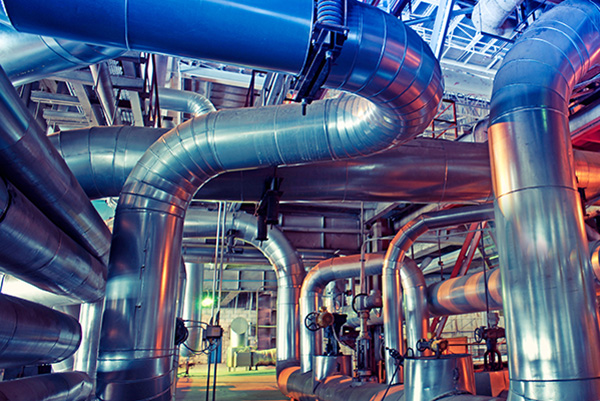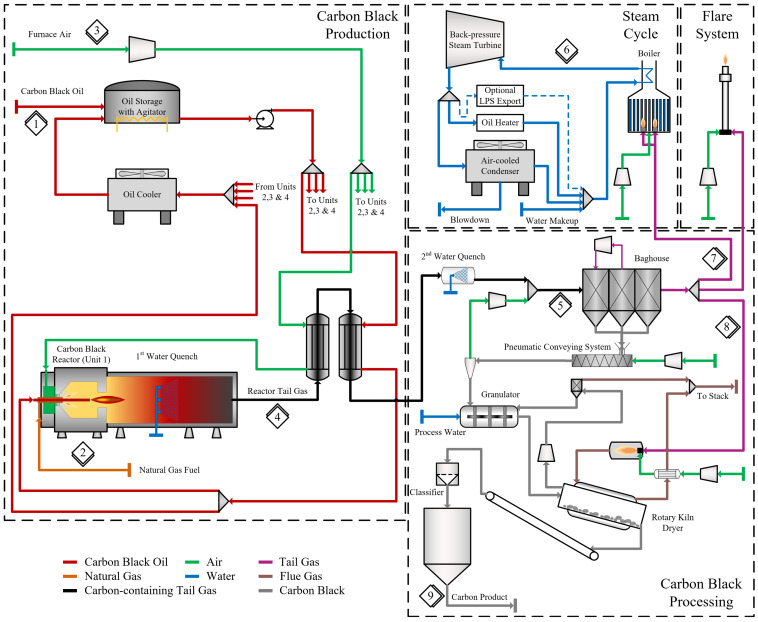Carbon Black Processes Overview
Carbon black is produced by the reaction of a hydrocarbon fuel such as oil or gas with a limited supply of combustion air at temperatures of 1,320 to 1,540°C (2,400 to 2,800°F). Major processes used to manufacture carbon blacks are as shown below. In each of these process types, the unburned carbon is collected as an extremely fine black fluffy particle, from 10 to 500 nanometers (nm) in diameter[1-3].
- Partial Oxidation Processes
- Lamp black process
- Channel black process
- Gas black process
- Furnace black process
- Thermal Decomposition Processes
- Acetylene decomposition
- Thermal black process
In the late 19th century carbon black started to be produced with the channel process. The industrial mass production started in the beginning of the 20th century, with the development of other carbon black production processes, mainly driven by expanding the tire industry[4].
By 1995, two major processes were used in the United States to manufacture carbon black, the oil furnace process and the thermal process. The oil furnace process accounts for about 90 percent of production, and the thermal process, about 10 percent. Two others, the lamp process for production of lamp black and the cracking of acetylene to produce acetylene black, were each used at one plant in the U.S. However, these are small-volume specialty black operations that constituted less than 1 percent of total production in this country[2].
Carbon Black Process Details
Lamp Black Process
This method obtains carbon black by collecting soot from fumes generated by burning oils or pine wood. This process is the oldest way to produce carbon black (formerly from oil lamps) and has been used since antiquity BC, and is not suitable for mass production. The heating is conducted on a cast-iron pan with the feedstock. Radiant heat from the hood causes the feedstock to vaporize and partially combust, most of it converted into carbon black, which is used as raw material for inks as it provides carbon black with specific color[4,5].
Figure 1 - Lamp Black Process Schematics[4,5].
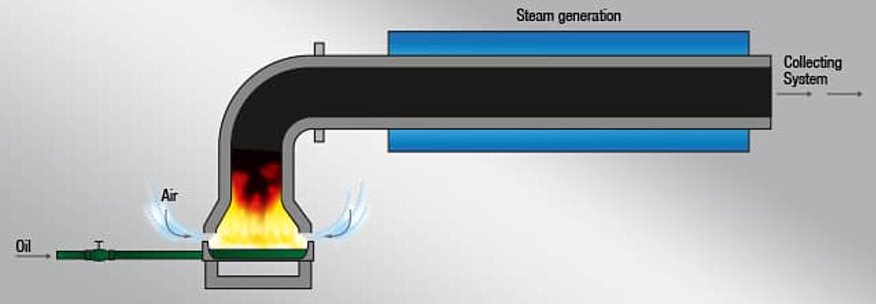
Channel Black Process
This method forms carbon black by bringing partially combusted fuel, which is generated with natural gas as raw material, into contact with channel steel (H-shaped steel). A large numbers of small flames fed by natural gas from ceramic burners impinge on the underside of a water-cooled steel channel, depositing a layer of carbon black that is periodically removed by scrapping devices. These iron channels, which moved slowly back and forth over the flames, have since lent their name to this manufacturing process. The deposited carbon black is scrapped off into a funnel-shaped trough and transferred by screw conveyers to storage silos. The yield of carbon black is only 5 percent. The channel process produces carbon black with a particle size of 10 to 30 nm. The carbon black particle size can be altered by the distance of the burner tip from the channel and changing the natural gas and air flow rates. Nowadays the channel black process is primarily used to manufacture carbon black pigments with very fine particles, which are primarily distinguished by their high content of oxygen-containing surface groups.[3-5].
Figure 2 - Channel black (natural gas as feedstock) / Gas black (coal tar distillates as raw material) Process Schematics[4].
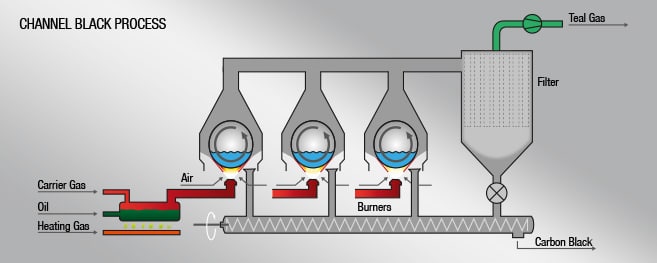
Gas Black Process
The Gas Black method developed by Degussa in the mid-1930s is closely related to the Channel Black process developed in the US based on natural gas as the feedstock. As natural gas was much scarcer in Europe, the Degussa Gas Black method was developed to use coal tar distillates as raw material instead. The oil is heated in a vaporizer and the resultant vapors are carried by a hydrogen-rich gas into a gas tube that is fitted with a multiplicity of burners. The individual flames impinge on the surface of a water-cooled drum. A portion of the carbon Black that is generated is deposited on the roller while the rest enters the filter system. In the next stage the two carbon black streams are combined. Onward processing is then similar to the Furnace Black process. While it is possible to control the raw material fed by the carrier gas stream, the air has free access. However, despite this restriction, the Gas Black method allows the production of Carbon Black with primary particle sizes ranging from 10 to 30 nm. While in the past these types of Carbon Black were used predominantly in tire tread formulations, they are now used almost exclusively in pigment applications where the fine-particle Gas Blacks are of particular importance[7].
Furnace Black Process
The oil furnace production method (Table 1 / Fig. 3 & 4), which uses the incomplete combustion of aromatic liquid hydrocarbon feedstock, is currently the most common method. In this method, the process starts when a factory receives heavy residual oil (feedstock) from suppliers. Feedstock charge pumps then send the fuel oil to production lines, where it is heated to allow it to run through pipes. This is then injected continuously into the combustion zone of a natural gas-fired furnace (reactor), where it is decomposed to form carbon black. The furnace internal walls are typically lined with a refractory to contain the heat generated by the process[1,2].
Primary quench water cools the gases to 500°C (1,000°F) to stop the cracking. The exhaust gases entraining the carbon particles are further cooled to about 230°C (450°F) by passage through heat exchangers and direct water sprays. The black is then separated from the gas stream, usually by a fabric filter. A cyclone for primary collection and particle agglomeration may precede the filter. A single collection system often serves several manifolded furnaces[2].
Figure 3 - Furnace Black Process Schematics[4].

By varying the amount of oil, air and temperature, the process can be manipulated to produce different particle sizes. The exhaust gases from the incomplete combustion are further cooled to about 230°C (450°F) by passage through heat exchangers and direct water sprays[1]. Process yields range from 35 to 65 percent, depending on the feed composition and the grade of black produced. Furnace designs and operating conditions determine the particle size and the other physical and chemical properties of the black. Generally, yields are highest for large particle blacks and lowest for small particle blacks[2].
The recovered carbon black is finished to a marketable product by pulverizing and wet pelletizing to increase bulk density. Water from the wet pelletizer is driven off in a gas-fired rotary dryer. Oil or process gas can be used. From 35 to 70 percent of the dryer combustion gas is charged directly to the interior of the dryer, and the remainder acts as an indirect heat source for the dryer. The dried pellets are then conveyed to bulk storage[2].
Figure 4 - Flow diagram for the oil furnace carbon black process[2].

Table 1 - Stream Identification for the Furnace Process as depicted in Fig. 1.[2].
| Stream |
Identification |
Stream |
Identification |
1
2
3
4
5
6
7
8
9
10
11
12
13
14
15
16
17
18
19
20 |
Oil feed
Natural gas feed
Air to reactor
Quench water
Reactor effluent
Gas to oil preheater
Water to quench tower
Quench tower effluent
Bag filter effluent
Vent gas purge for dryer fuel
Main process vent gas
Vent gas to incinerator
Incinerator stack gas
Recovered carbon black
Carbon black to micropulverizer
Pneumatic conveyor system
Cyclone vent gas recycle
Cyclone vent gas
Pneumatic system vent gas
Carbon black from bag filter |
21
22
23
24
25
26
27
28
29
30
31
32
33
34
35
36
37
38
39 |
Carbon black from cyclone
Surge bin vent
Carbon black to pelletizer
Water to pelletizer
Pelletizer effluent
Dryer direct heat source vent
Dryer heat exhaust after bag filter
Carbon black from dryer bag filter
Dryer indirect heat source vent
Hot gases for dryer
Dried carbon black
Screened carbon black
Carbon black recycle
Storage bin vent gas
Bagging system vent gas
Vacuum cleanup system vent gas
Combined dryer vent gas
Fugitive emissions
Oil storage tank vent gas
|
Acetylene Black Process
This process forms high purity carbon black by thermally decomposing acetylene gas in a closed reactor. Due to the production process, acetylene blacks differs from other carbon black grades. Acetylene blacks are available in powder form, as they are highly structured with a high degree of crystallinity, which makes it difficult to densify and impossible to pelletize. Due to a very high thermal as well as electrical conductivity, acetylene blacks are primarily used as conductive blacks in electric cells, antistatic rubber and plastic applications and cable manufacturing[4,5].
Figure 5 - Acetylene Black Process Schematics[6].
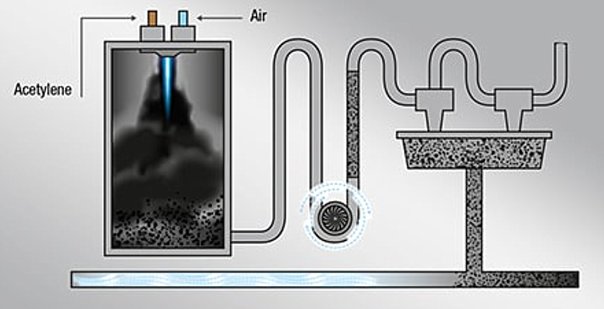
Thermal Black Process
The thermal black process is a cyclic operation with natural gas (methane) as the most commonly used feedstock, although higher grade hydro carbon oils are also used as feedstock material. In the process, natural gas is thermally decomposed (cracked) into carbon particles, hydrogen, and a mixture of other organics. Two furnaces are used in normal operation. The first cracks natural gas and makes carbon black and hydrogen. The effluent gas from the first reactor is cooled by water sprays to about 125°C (250°F), and the black is collected in a fabric filter. The filtered gas (90 percent hydrogen, 6 percent methane, and 4 percent higher hydrocarbons) is used as a fuel to heat a second reactor. When the first reactor becomes too cool to crack the natural gas feed, the positions of the reactors are reversed, and the second reactor is used to crack the gas while the first is heated. Normally, more than enough hydrogen is produced to make the thermal black process self-sustaining, and the surplus hydrogen is used to fire boilers that supply process steam and electric power[2,4].
Figure 6 - Thermal Process Schematics[4].

The collected thermal black is pulverized and pelletized to a final product in much the same manner as is furnace black. Thermal process yields are generally high (35 to 60 percent), and the carbon black produced has the largest particle size (180 to 470 nm) and among the lowest degrees of particle aggregation or structure. but the relatively coarse particles produced do not have the strong reinforcing properties required for rubber products. Since it is made from natural gas, it is also one of the purest forms of carbon available on an industrial scale.[2,4].
References
- CEERISK, Carbon black: the processes behind the product.
- U.S. Enrironmental Protection Agency, Jan 1995, Organic Chemical Process Industry, Carbon Black Process Description.
- D. Alwarid, 2022-2023 Lecture, Properties of Petroleum Products, 3rd Stage, Carbon Black, Ministry of Higher Education and Scientific Research, Al-Mustaqbal University College, Department of Chemical Engineering and petroleum Industrials.
- PENTACARBON, CARBON BLACK WIKI.
- MITSUBISHI CHEMICAL, Manufacturing Process of Carbon Black.
- Orion S.A., Processes.
- Orion, What is Carbon Black? Brochure.

